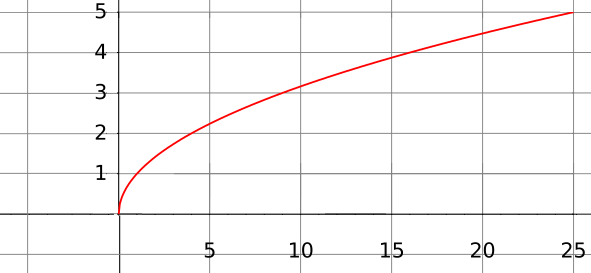Does a square root have two values?
This is part of a series on common misconceptions.
Is this true or false?
\[\large \sqrt{x^2} = \pm x\]
Why some people say it's true: That's exactly what I was taught in school: when you take a square root, the answer is always "plus or minus" some value.
Why some people say it's false: When you square \(x,\) it becomes positive no matter what it was before; then, when you take the square root, it's still positive. Therefore, the answer is just \(|x|\), not \(\pm x\).
The statement is \( \color{red}{\textbf{false}}\).
Explanation:
On its standard domain of non-negative real numbers, \(\sqrt{x}\) is defined as "the non-negative real number which, when squared, equals \(x.\)" For example, \(\sqrt{25} = 5\) not \(\pm 5\). \(\sqrt{x}\) is defined this way so that it is a function.
A function is a relation or map between a set of input values (the domain) and a set of output values (the range) which has the property that every accepted input corresponds with exactly one output. This property is commonly known as "passing the vertical line test."
In order for \(\sqrt{x}\) to be a function, its evaluation on any input must be a single, well-defined output. That is why it's defined as it is. Below is a graph of the square-root function. Note that it's only a single arm reaching out from the origin, not a rotation of a full parabola.

The graph of a \(90^\circ\) rotation of the whole \(x^2\) parabola would not pass the vertical line test and would not be a function.
Extending the Domain to All Real Numbers and the Range to Complex Numbers:
The behavior of the square root function when extended to the domain of all real numbers (positive reals, negative reals, and 0) precisely mirrors the argument made above. The square root of a negative number is a complex number. But, even with its domain extended, \(\sqrt{x}\) is similarly defined so that it is still a function. For example, \(\sqrt{-25} = 5i\) not \(\pm 5i\).
Rebuttal: But \(x^2=y\) almost always has two solutions. For example, when \(y=25\), \(x=5\) and \(x=-5\) are both solutions. And this is only one case of the general rule that I learned in school: when you're solving an equation and take the square root of both sides in the process, \(x^2\) becomes \(\pm x\). For example, \(x^2=25\) becomes \(x=\pm 5\).Reply: \(y=x^2\) does have two solutions, i.e. both \(x=5\) and \(x=-5\) are correct, but you're merging two steps of the process you were taught in school when you think about the rule this way. In school, you were likely shown this technique for solving simple quadratic equations in two steps:
Given: \(x^2=25\)
Step 1: \( x=\pm\sqrt{25}\)
Step 2: \(\pm\sqrt{25} = \pm 5\)The \(\pm\) is applied this way precisely because the square root is limited in its range to only positive values, whereas the function \(x^2\) has a domain of both positive and negative values. But the evaluation of the square root itself is simply 5.
The actual rule is that, when you want to invert the \(x^2\) function, likely because you're solving for a variable or expression that has been squared, you have to put a \(\pm\) in front of the square root of the side that was not squared initially so that you can include the domain of all negative numbers as potential inputs to the \(x^2\) function.
The misconception here stems from this whole process frequently being referred to as "taking the square root of both sides." That's a misleading way to describe what you're doing since, in actuality, you are manually applying an actual inversion of the \(x^2\) function to both sides of the equation.
Rebuttal: The square root is the inverse function of \(x^2\). That means that they just cancel out. So, \( \sqrt{x^2}\) is simply \(x\), no matter what \(x\) is.
Reply: The square root function is not the inverse of \(x^2\) for all real numbers. Instead, it is an inverse of \(x^2\) only on the interval \( [0, \infty)\).
Here is a graph of the square-root function. Note that it's only a single arm reaching out from the origin, not a rotation of a full parabola.

Rebuttal: \(\large \sqrt{x^2} = \pm x\) is not a function. It is an equation. Restrictions on the singular output of a function would only apply when the square root is found a function's value determination.
Evaluate
\[\frac{\sqrt{x^2}}{|x|} + 1,\]
where \(x\) is a non-zero real number.
See Also